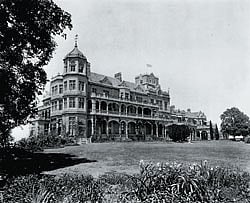'Glittering Decades' speaks of New Delhi as seen through the eyes of its privileged inhabitants between 1931 and 1952. It focusses on the impact that the Raj and Independence had on the upper classes of Delhi’s society, writes M K Chandra Bose

New Delhi’s obsession with status and privilege is nothing new. Lutyens’ Delhi remained the foremost symbol of British imperial might, with the population segregated on racial and hierarchical lines with strict social codes of conduct. After the dawn of freedom, the city found it difficult to break free from imperialistic rituals and social formalities. While in the colonial era the city lived in its horse shows, balls, jazz parties and nightclubs, the new rulers adapted some of the etiquettes and protocols to suit the new context. The imperial legacy lingered.
In Glittering Decades, Nayantara Pothen, an Australia-based Indian writer and researcher, tells the story of New Delhi through the eyes of its privileged inhabitants between 1931, the year of its inauguration, and 1952, year of the first general elections. Focussing on the social life and rituals, she examines what impact the politics of the Raj and Independence had on the cocooned lives of the upper echelons of New Delhi society. The chronicle brings alive the capital’s social life in the twilight years of the colonial era and the heady years of independence. The author relies extensively on the accounts given by women of the Raj.
The grandiose dream of colonial masters to make New Delhi the ultimate bastion of imperial power remained unfulfilled. By the time the capital was inaugurated, historical events had overtaken it drastically, altering the political context. In Lutyens’ Delhi, residential areas were allotted according to race, occupational rank and socio-economic status. The native population was largely confined to the periphery. At the pinnacle were the ‘heaven-born’ Indian Civil Service mostly comprising Englishmen. The very few Indians in the ICS ranks were not treated on par with their western counterparts. There was little warmth and intimacy between Indians and Britishers.
Racial and social segregation at vice-regal circles was the norm. When Viceroy Lord Linlithgow hosted a party for his officials in Simla, Indians were served in the garden or the verandah while Europeans were served in the vice-regal residence. Clubs like New Delhi Gymkhana remained out of bounds for Indians. In imperial New Delhi, Indians, no matter how western-educated or westernised, were subordinate. At dinner parties, who was seated with whom mattered a lot. The official warrant of precedence was ‘Bible for social conduct’. Along with the regimented formality and decorum, the life of New Delhi elite was centred on activities of leisure and social pursuits. “Life then was a hectic whirl of dinner parties, balls and outings of various kinds,” says Nayantara.
It was World War II that jolted the ruling elite, transforming their social life. The
influx of a large contingent of US soldiers did make a dent in the regimented social life. Sudden increase in the population and intense political developments turned New Delhi into a ‘curious mix of formality and cosmopolitanism’. The rising anti-British sentiments, the impact of Congress-Muslim League tussle on personal relations, rise of communal politics leading to Partition and the explosion of joy on New Delhi streets at midnight on August 14, 1947, all receive adequate attention. The book captures the spirit of the midnight celebration for which most participants chose to wear Indian dresses.
The trauma of Partition left deep scars on the city. Privileged status no more guaranteed one’s safety. The spate of blood-letting and influx of refugees transformed the face of New Delhi. With the capital ceasing to be a British enclave, everything changed for the whites. Being accountable to Indian politicians was a harsh reality they couldn’t stomach. The new rulers who were ambivalent on imperial etiquette and protocol only made subtle changes. Nayantara contends that the significance of social ritual, hierarchy, precedence and protocol in New Delhi society remained the same. Between 1947 and 1952, the new leaders co-opted the imperial symbols of authority and control.The new privileged class
included politicians, diplomats and businessmen.
Delightful anecdotes enliven the pages. Here is an abiding symbol of the rural India coming to terms with the hallowed seat of the colonial might. During the tenure of Rajendra Prasad as the president, the first lady insisted on milking her six cows herself and the bovines were soon found tethered to the gilded taps of one of the grand bathrooms of Rashtrapati Bhavan.
Another incident relates how the privileged class had become paranoid during communal riots. Sardar K M Panikkar shaved off his carefully preserved goatee in self-defence. Had the author focussed solely on lifestyle, Glittering Decades would have made a better impact. She has failed to go beyond the personal accounts from the island of privilege. Nevertheless, this well-researched work is a valuable addition to social history that Indians have traditionally neglected.
Glittering decades
Nayantara Pothen
Penguin
2012, pp 268
Rs 499
